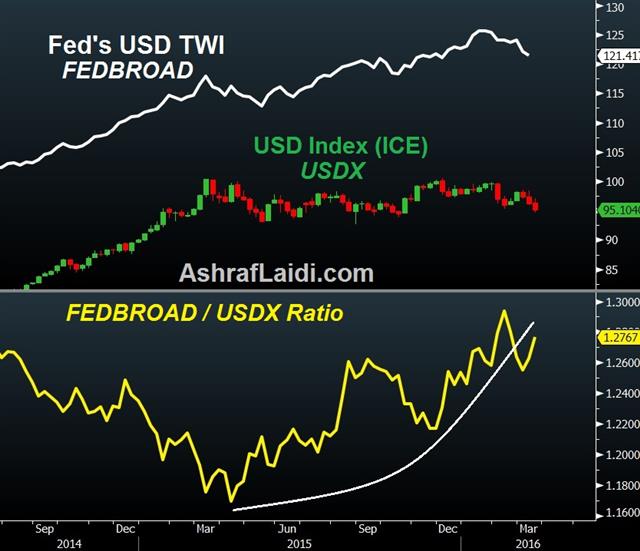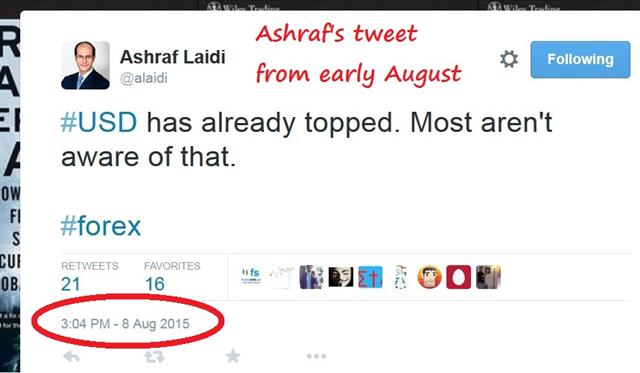Leaving Long Island
What do the US dollar rally and a Donald Trump rally have in common? Scroll down to the bottom for the answer.
This week's Fed decision to tone down its FedFunds projections closer to those of the bond market sent the US dollar falling by its biggest 2-day decline since 2009. The US central bank finally realizes it is unable to isolate itself in an island of higher interest rate expectations and an appreciating currency as the other major central banks race towards negative interest rates. The Fed is set to leave that Island.
One of the loudest messages (and reminders) from the currency markets is the importance of expectations-based yield differentials. It does not matter that the ECB main interest rate (refinancing rate) is at zero and the US Fed Funds rate target is at 0.50%. What matters instead is that negative deposit rates at the ECB are less likely to deepen into negative territory than are US interest rates likely to push further higher. What also matters is that US interest rates/yields face greater downside potential than do ECB rates.
Inflation is the other detail. The Fed has demonstrated its willingness to await further evidence of stabilizing inflation before risking any immature tightening with the benefit of a correction in the US dollar. The ECB will not be in a rush to raise rates once CPI gets back above 0% from -0.2%, but trades will quickly push the euro back up as was the case last spring when inflation reached rose to 0.3% from -0.6% in a matter of 4 months.
I could also mention the current account surpluses in the Eurozone and Japan at 3% and 3.3% of GDP respectively compared to -2.7% of GDP for the US, which help explain risk aversion flows in the euro and the yen. But no need for that at this time.
As it stands, FX markets are currently experiencing the Fed's long-awaited embrace of reality. Whether this lasts for 3 weeks or 3 months remains to be seen.
When I said back in August that the peak in the US dollar had already occurred, many disagreed (see tweet below). I was obviously referring to the 6-currency index, traded at the IntercontinentalExchange (formerly NYBOT) and dominated by the euro (57.6%) and the yen (13.6%).
Those who disagreed with me protested that the 6-currency basket is an inaccurate measure of the US currency as it was skewed by euro and yen movements without taking into consideration the greenbacks' performance against EM. The importance of of the ICE's USDX is underscored by its viavility as a trading tool by Commodity Trade Advisors and hedge funds as well as its influence in the CME's futures committments data by speculators, which currently show USDX net longs at fresh 2-year lows. Indeed, EURUSD bottomed in March 2015 (the start of ECB's QE) and USDJPY peaked three months later, which helps explain the top in USDX in mid-March on a closing weekly basis and not on intraweek basis.
Those who prefer the Fed's trade-weighted index (measured against the Eurozone, Canada, Japan, Mexico, China, United Kingdom, Taiwan, Korea, Singapore, Hong Kong, Malaysia, Brazil, Switzerland, Thailand, Philippines, Australia, Indonesia, India, Israel, Saudi Arabia, Russia, Sweden, Argentina, Venezuela, Chile and Colombia) will naturally find a higher USD index as it is dominated by emerging markets. Economists and USD-bulls in need of a confirmation bias will most commonly use this index. But if you trade FX with a focus on EUR and JPY, then USDX cannot be ignored.
The chart below highlights the outperformance of the Fed's TWI index relative to that of the ICE's USDX mainly due to the greater impact of the rising euro and yen in dragging down USDX. The rise in the Fed's USD TWI / USDX ratio reflects the outperformance of the euro and yen relative to EM currencies. As long as the latter is unable to extend a meaningful recovery over EUR and JPY, the ratio shall remain bullish and market obersevers focusing on the Fed's USD TWI will continue searching for clues.

Both of the USD rally and Donald Trump rally get overcrowded too quickly. Trouble occurs when that happens.








